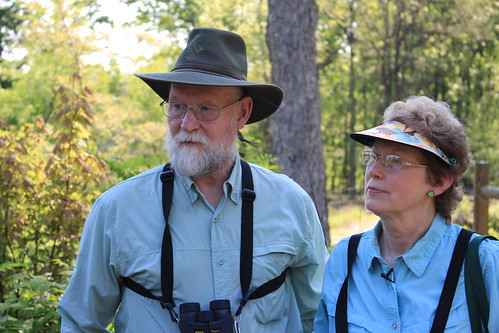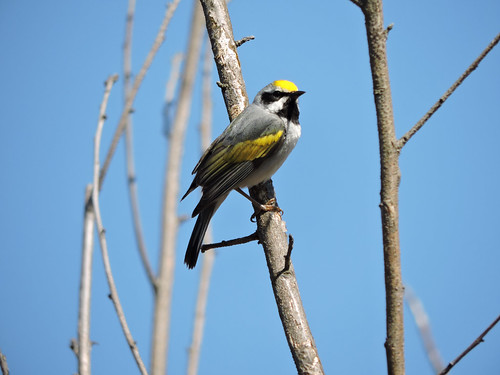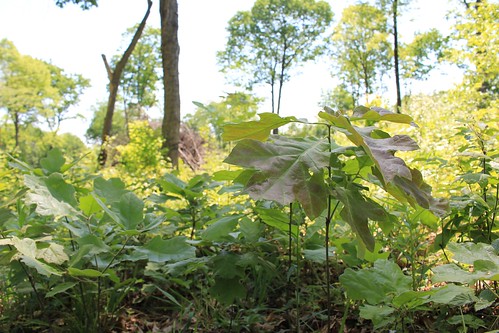
For Mike and Laura Jackson, many mornings begin with hot tea and birds. This particular morning, they spotted a mourning dove, a pileated woodpecker and many others. And the retired science teachers in Bedford County, Pennsylvania jot down the types and numbers of birds they see each day.
While they bird in some exotic places, much of their time is spent at home on their property, Mountain Meadows, which is home to 114 acres of forestland that they’re actively managing to provide high-quality habitat for a variety of species.
“I have a passion for wildlife and consider myself a nature lover,” Laura says.
One day, they hope to spot a golden-winged warbler on their land. This at-risk songbird spends its spring and summers in the Appalachians, where it seeks patches of young forest for breeding and nesting.

Young Forests
Mike and Laura live in a sea of green in the middle of the Appalachian Mountains near Everett, Pennsylvania.
Across the East, forests are all about the same age. At the turn of the 20th Century, widespread logging set the stage for a landscape of even-aged forests. Nowadays, development, fire suppression, pests and either a lack of management or poor management have impacted the health of forests across the region.
Different species need different ages of forest for survival. In the case of the golden-winged warbler, they nest amid young trees and thick shrubs, but when the next generation is ready to leave the nest, they head for older forests. The golden-winged warbler is often regarded as a flagship species for diverse forests, as it needs different ages of forests at different times of its life.
Managing for Diversity
Landowners like the Jacksons are bringing active management back to the forest. They are using a variety of sustainable forestry practices to manage for those patches of young forest that the golden-winged warbler needs for nesting, all while putting their land on track to be a healthier, higher quality forest.
The Jacksons worked with foresters, scientists, government agencies and loggers to control non-native and invasive plants, exclude deer from certain areas and remove less desirable trees. The healthiest trees were retained for the long-term. These residual trees provide food like hickory nuts and acorns for turkeys and other wildlife and song perches and places to forage for birds like the golden-winged warbler.
“We have an area of about 30 acres that we logged to improve the habitat for golden-winged warbler and attract species that rely on young forest habitat,” Mike says.
With the majority of the trees removed, more sunlight reaches the ground, spurring lots of new growth. It’s not just the golden-winged warbler that prospers. Many game and non-game species flourish in young forest habitat, including American woodcock, white-tailed deer, ruffed grouse and wild turkey.
“Families, hunting clubs and other private forest landowners managing for wildlife habitat and timber production can benefit from sustainably managed forests,” said Emily Heggenstaller, a golden-winged warbler partner biologist with USDA’s Natural Resources Conservation Service (NRCS) who helped the Jacksons plan and carry out their forestry practices.
Assistance for Forest Management
The Jacksons received ample help along the way. They worked with NRCS and Pennsylvania Game Commission, as well as several other conservation partners to plan and implement sustainable forestry practices.
They are part of a regional conservation effort to manage habitat for the golden-winged warbler, called Working Lands for Wildlife (WLFW), which has led to the creation of 13,000-plus acres of habitat throughout Appalachia. As part of the effort, NRCS covers part of the cost for implementing practices, such as early successional habitat development and management, forest stand improvement and brush management.
“The focus of this effort is to create habitat for these at-risk songbirds while also encouraging sustainable forestry and diversity, which in turn also benefits other wildlife species,” said Brad Michael, NRCS district conservationist in Bedford.
For more information on NRCS assistance for managing forests, contact their local USDA service center as well as visit NRCS’ “Managing for Healthy, Diverse Forests” multimedia story. To learn more about the Jacksons and their conservation work, visit NRCS’ “Good Forest Management Yields Wildlife Oasis” multimedia story.

